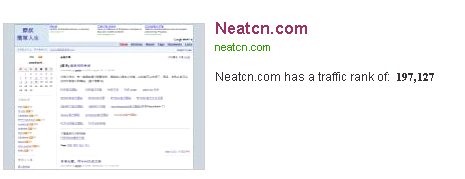Submitted by gouki on 2008, November 27, 6:58 PM
在ubuntu下面默认是不能mount samba共享的目录的,而在公司里,我不得不连接这样的目录,在windows下面的时候,samba共享就象windows的共享目录那样的方便,但是在linux下面就不是这样的了。
首先,你要下载smbmount,运行 :
apt-get install smbfs
然后就会安装smbmount了,我自己Ubuntu系统的loacle设置是:zh_CN.UTF-8,相信大多数使用ubuntu的人都是这样设置的吧,平时使用samba的话,直接输入smb://hostname 就可以了。
然后尝试一下把公司服务器上的路径mount过来。
smbmount //hostname/directory /home/my/mount/dir -o user=username,pass=passpord,iocharset=utf8
在上面的命令里
//hostname/directory 就是公司服务器的samba共享路径,
/home/my/mount/dir 就是本地的挂载目录,
-o 参数是表示后面还有很多参数,参数之间以","(不含引号)隔开
user表示用户名
pass表示密码
iocharset=utf8,可以避免中文乱码
Tags: linux, ubuntu, samba, mount
苹果相关 | 评论:1
| 阅读:57305
Submitted by gouki on 2008, November 21, 10:50 AM
恭喜一下自己,alexa的排名终于进了20万位了
查看alexa上面本网站的排名
下面附上小图。。


Tags: alexa, 排名, pr, page rank, traffic
Misc | 评论:2
| 阅读:21017
Submitted by gouki on 2008, November 8, 6:27 PM
百日照前剪的头发,坚持着没有被人忽悠做胎毛笔,呵呵。由于小孩经常被吓醒,所以外婆把头发留下来,做了一个类似于香囊的东西,把头发放在里面。
拍照留念一下:
图片附件(缩略图):

图片附件(缩略图):

图片附件(缩略图):

Tags: 肖佑阳, 头发, 胎毛
Scala & Ruby | 评论:0
| 阅读:23955
Submitted by gouki on 2008, August 20, 11:53 PM
1.6版本的zf终于将SOAP放进来了,同时也增加了DOJO的支持。不过我没有想通。为什么那么多的JS框架,最终会选择了DOJO。
这些不是我能够想得通的。还是看看到底更新了什么再说吧。
An overview of new features:
- Dojo Integration
- JSON-RPC
- Dojo Data packing
- Dojo View Helper
- Dijit integration with Zend_Form & Zend_View
- Dojo Library Distribution
- SOAP
- SOAP Server
- SOAP Client
- Autodiscovery
- WSDL access
- WSDL Generation
- Preview of Tooling Project in Laboratory (see /laboratory folder)
- Command Line Interface
- Project Asset Management
- Unit Testing Harness for Controllers
- Lucene 2.3 Index File Format Support
- Zend_Session save handler for Database Tables
- Paginator Component
- Text/Figlet Support
- ReCaptcha Service
- Zend_Config_Xml Attribute Support
- Character Set Option for DB Adapters
- Zend File Transfer Component
- New Media View Helpers (Flash, Quicktime, Object, and Page)
- Support in Zend_Translate for INI File Format
This obviously marks a very important step towards a high-quality, highly tested 1.6 GA release. Thanks to everyone who has contributed to this release in any way: with patches/check ins, documentation/translations, and bug reports.
But our work is not yet over! Let's do our best to bring this release to the breaking point to find areas we can improve the release for General Availability. Based on your feedback we will determine in the next few weeks whether we require additional release candidates, so please provide feedback on our issue tracker (http://framework.zend.com/issues) as soon as you can and ask any questions/post your experiences on the appropriate mailing list.
Again, the Zend Framework community does NOT recommend this release for production use. We do, however, recommend evaluating new features in this release with existing and new applications.
Enjoy 1.6RC1, and see you on the issue tracker, wiki, and mailing lists!
————END————
不知道:Zend File Transfer Component,这个会给我们带来什么样的惊喜?大文件传输还是其他的?下载源码研究一下,哈哈
Tags: soap, zend framework, zf, framework, dojo
PHP Framework | 评论:0
| 阅读:26856
Submitted by gouki on 2008, February 17, 3:00 PM
提起Zend,那是在PHP界是相当的有名啊。如果说使用PHP的人居然连Zend也不知道,那是白活了。呵呵
ZendFramework是Zend公司自己推出的一个框架,开发人员都是些元老级人物(但也是有BUG的。。自我安慰一下,高手也会产生BUG),ZF在经历了很长一段时间的发展(大约一年左右吧),才推出1.0系列,现在的版本当然又有了更新

» 阅读全文
Tags: zf, zend, framework
PHP Framework | 评论:0
| 阅读:34950








